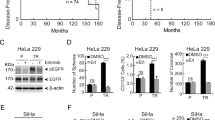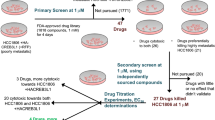Abstract
Paclitaxel has been extensively used as an antitumor drug to treat a broad range of epithelial cancers, including breast and cervical cancers. However, the efficacy of this drug is greatly limited by the development of acquired resistance. Identification of the underlying resistance mechanisms may inform the development of new therapies that elicit long-term response of tumors to paclitaxel treatment. Here we report that increased expression of TNFAIP1 (tumor necrosis factor alpha-induced protein 1) confers acquired resistance to paclitaxel. TNFAIP1 is shown to compete with paclitaxel for binding to β-tubulin, thereby preventing paclitaxel-induced tubulin polymerization, cell cycle arrest and ultimate cell death. We also show that expression of TNFAIP1 is regulated by the transcriptional factor Sp1. In a xenograft mouse model, increased expression of TNFAIP1 decreases, whereas knockdown of TNFAIP1 increases tumor response to paclitaxel. Therefore, these results reveal tnfaip1 as a novel paclitaxel-resistance associated gene and suggest that TNFAIP1 may represent a valuable therapeutic target for the treatment of cancer.
This is a preview of subscription content, access via your institution
Access options
Subscribe to this journal
Receive 50 print issues and online access
$259.00 per year
only $5.18 per issue
Buy this article
- Purchase on Springer Link
- Instant access to full article PDF
Prices may be subject to local taxes which are calculated during checkout






Similar content being viewed by others
References
Wani MC, Taylor HL, Wall ME, Coggon P, McPhail AT . Plant antitumor agents. VI. The isolation and structure of taxol, a novel antileukemic and antitumor agent from Taxus brevifolia. J Am Chem Soc 1971; 93: 2325–2327.
Parness J, Horwitz SB . Taxol binds to polymerized tubulin in vitro. J Cell Biol 1981; 91: 479–487.
Ojima I, Chakravarty S, Inoue T, Lin S, He L, Horwitz SB et al. A common pharmacophore for cytotoxic natural products that stabilize microtubules. Proc Natl Acad Sci USA 1999; 96: 4256–4261.
Schiff PB, Horwitz SB . Taxol stabilizes microtubules in mouse fibroblast cells. Proc Natl Acad Sci USA 1980; 77: 1561–1565.
De Brabander M, Geuens G, Nuydens R, Willebrords R, De Mey J . Taxol induces the assembly of free microtubules in living cells and blocks the organizing capacity of the centrosomes and kinetochores. Proc Natl Acad Sci USA 1981; 78: 5608–5612.
Milross CG, Mason KA, Hunter NR, Chung WK, Peters LJ, Milas L . Relationship of mitotic arrest and apoptosis to antitumor effect of paclitaxel. J Natl Cancer Inst 1996; 88: 1308–1314.
Hennequin C, Giocanti N, Favaudon V . S-phase specificity of cell killing by docetaxel (Taxotere) in synchronised HeLa cells. Br J Cancer 1995; 71: 1194–1198.
Jordan MA, Wendell K, Gardiner S, Derry WB, Copp H, Wilson L . Mitotic block induced in HeLa cells by low concentrations of paclitaxel (Taxol) results in abnormal mitotic exit and apoptotic cell death. Cancer Res 1996; 56: 816–825.
Torres K, Horwitz SB . Mechanisms of Taxol-induced cell death are concentration dependent. Cancer Res 1998; 58: 3620–3626.
Giannakakou P, Robey R, Fojo T, Blagosklonny MV . Low concentrations of paclitaxel induce cell type-dependent p53, p21 and G1/G2 arrest instead of mitotic arrest: molecular determinants of paclitaxel-induced cytotoxicity. Oncogene 2001; 20: 3806–3813.
Rowinsky EK . The development and clinical utility of the taxane class of antimicrotubule chemotherapy agents. Annu Rev Med 1997; 48: 353–374.
Slichenmyer WJ, Von Hoff DD . New natural products in cancer chemotherapy. J Clin Pharmacol 1990; 30: 770–788.
Einzig AI, Wiernik PH, Schwartz EL . Taxol: a new agent active in melanoma and ovarian cancer. Cancer Treatment Res 1991; 58: 89–100.
Cerny T, Kaplan S, Pavlidis N, Schoffski P, Epelbaum R, van Meerbeek J et al. Docetaxel (Taxotere) is active in non-small-cell lung cancer: a phase II trial of the EORTC Early Clinical Trials Group (ECTG). Br J Cancer 1994; 70: 384–387.
Ilson DH, Wadleigh RG, Leichman LP, Kelsen DP . Paclitaxel given by a weekly 1-h infusion in advanced esophageal cancer. Ann Oncol 2007; 18: 898–902.
Seidman AD . The emerging role of paclitaxel in breast cancer therapy. Clin Cancer Res 1995; 1: 247–256.
Suzuki M, Nishimura Y, Nakamatsu K, Kanamori S, Koike R, Kawamoto M et al. Phase I study of weekly docetaxel infusion and concurrent radiation therapy for head and neck cancer. Jpn J Clin Oncol 2003; 33: 297–301.
Bai ZG, Qu X, Han W, Ma XM, Zhao XM, Zhang ZT . Expression of taxol resistance gene 1 correlates with gastric cancer patient clinical outcome and induces taxol resistance. Mol Med Rep 2010; 3: 1071–1078.
Stordal B, Hamon M, McEneaney V, Roche S, Gillet JP, O'Leary JJ et al. Resistance to paclitaxel in a cisplatin-resistant ovarian cancer cell line is mediated by P-glycoprotein. PloS ONE 2012; 7: e40717.
Bradley G, Ling V . P-glycoprotein, multidrug resistance and tumor progression. Cancer Metastasis Rev 1994; 13: 223–233.
Burkhart CA, Kavallaris M, Band Horwitz S . The role of beta-tubulin isotypes in resistance to antimitotic drugs. Biochim Biophys Acta 2001; 1471: 1–9.
Cheung CH, Wu SY, Lee TR, Chang CY, Wu JS, Hsieh HP et al. Cancer cells acquire mitotic drug resistance properties through beta I-tubulin mutations and alterations in the expression of beta-tubulin isotypes. PloS ONE 2010; 5: e12564.
Wang Y, Yin S, Blade K, Cooper G, Menick DR, Cabral F . Mutations at leucine 215 of beta-tubulin affect paclitaxel sensitivity by two distinct mechanisms. Biochemistry 2006; 45: 185–194.
Yin S, Bhattacharya R, Cabral F . Human mutations that confer paclitaxel resistance. Mol Cancer Ther 2010; 9: 327–335.
Kamath K, Wilson L, Cabral F, Jordan MA . BetaIII-tubulin induces paclitaxel resistance in association with reduced effects on microtubule dynamic instability. J Biol Chem 2005; 280: 12902–12907.
Seve P, Reiman T, Dumontet C . The role of betaIII tubulin in predicting chemoresistance in non-small cell lung cancer. Lung Cancer 2010; 67: 136–143.
Wang Y, Cabral F . Paclitaxel resistance in cells with reduced beta-tubulin. Biochim Biophys Acta 2005; 1744: 245–255.
Lih CJ, Wei W, Cohen SN . Txr1: a transcriptional regulator of thrombospondin-1 that modulates cellular sensitivity to taxanes. Genes Dev 2006; 20: 2082–2095.
Duan Z, Foster R, Brakora KA, Yusuf RZ, Seiden MV . GBP1 overexpression is associated with a paclitaxel resistance phenotype. Cancer Chemother Pharmacol 2006; 57: 25–33.
Dong Y, Tan OL, Loessner D, Stephens C, Walpole C, Boyle GM et al. Kallikrein-related peptidase 7 promotes multicellular aggregation via the alpha(5)beta(1) integrin pathway and paclitaxel chemoresistance in serous epithelial ovarian carcinoma. Cancer Res 2010; 70: 2624–2633.
Blagosklonny MV, Fojo T . Molecular effects of paclitaxel: myths and reality (a critical review). Int J Cancer 1999; 83: 151–156.
Cambray-Deakin MA, Burgoyne RD . Posttranslational modifications of alpha-tubulin: acetylated and detyrosinated forms in axons of rat cerebellum. J Cell Biol 1987; 104: 1569–1574.
Liu M, Sun Z, Zhou A, Li H, Yang L, Zhou C et al. Functional characterization of the promoter region of human TNFAIP1 gene. Mol Biol Rep 2010; 37: 1699–1705.
Horwitz SB, Cohen D, Rao S, Ringel I, Shen HJ, Yang CP . Taxol: mechanisms of action and resistance. J Natl Cancer Inst Monogr 1993. 55–61.
Wolf FW, Marks RM, Sarma V, Byers MG, Katz RW, Shows TB et al. Characterization of a novel tumor necrosis factor-alpha-induced endothelial primary response gene. J Biol Chem 1992; 267: 1317–1326.
Link CD, Taft A, Kapulkin V, Duke K, Kim S, Fei Q et al. Gene expression analysis in a transgenic Caenorhabditis elegans Alzheimer's disease model. Neurobiol Aging 2003; 24: 397–413.
Lin MC, Lee NP, Zheng N, Yang PH, Wong OG, Kung HF et al. Tumor necrosis factor-alpha-induced protein 1 and immunity to hepatitis B virus. World J Gastroenterol 2005; 11: 7564–7568.
Zhou J, Hu X, Xiong X, Liu X, Liu Y, Ren K et al. Cloning of two rat PDIP1 related genes and their interactions with proliferating cell nuclear antigen. J Exp Zool A Comp Exp Biol 2005; 303: 227–240.
Kim DM, Chung KS, Choi SJ, Jung YJ, Park SK, Han GH et al. RhoB induces apoptosis via direct interaction with TNFAIP1 in HeLa cells. Int J Cancer 2009; 125: 2520–2527.
Yao Z, Duan S, Hou D, Heese K, Wu M . Death effector domain DEDa, a self-cleaved product of caspase-8/Mch5, translocates to the nucleus by binding to ERK1/2 and upregulates procaspase-8 expression via a p53-dependent mechanism. EMBO J 2007; 26: 1068–1080.
Wang J, He Q, Han C, Gu H, Jin L, Li Q et al. p53-facilitated miR-199a-3p regulates somatic cell reprogramming. Stem Cells 2012; 30: 1405–1413.
Minotti AM, Barlow SB, Cabral F . Resistance to antimitotic drugs in Chinese hamster ovary cells correlates with changes in the level of polymerized tubulin. J Biol Chem 1991; 266: 3987–3994.
Acknowledgements
This work was supported by grants from National Natural Science Foundation of China 31030046 (to MW) and 31171316 (to YM); the Ministry of Science and Technology of China (2010CB912804 and 2011CB966302); Chinese Academy of Sciences (XDA01020104) and the Fundamental Research Funds for Central Universities (WK2060190018).
Author information
Authors and Affiliations
Corresponding authors
Ethics declarations
Competing interests
The authors declare no conflict of interest.
Additional information
Supplementary Information accompanies this paper on the Oncogene website
Supplementary information
Rights and permissions
About this article
Cite this article
Zhu, Y., Yao, Z., Wu, Z. et al. Role of tumor necrosis factor alpha-induced protein 1 in paclitaxel resistance. Oncogene 33, 3246–3255 (2014). https://doi.org/10.1038/onc.2013.299
Received:
Revised:
Accepted:
Published:
Issue Date:
DOI: https://doi.org/10.1038/onc.2013.299
Keywords
This article is cited by
-
The emerging role of the KCTD proteins in cancer
Cell Communication and Signaling (2021)
-
Circ0001320 inhibits lung cancer cell growth and invasion by regulating TNFAIP1 and TPM1 expression through sponging miR-558
Human Cell (2021)
-
The role of TNF-α induced protein 1 in the activation of pro-apoptotic proteins
Human Cell (2021)
-
The CRL3BTBD9 E3 ubiquitin ligase complex targets TNFAIP1 for degradation to suppress cancer cell migration
Signal Transduction and Targeted Therapy (2020)
-
Superhero Rictor promotes cellular differentiation of mouse embryonic stem cells
Cell Death & Differentiation (2019)



